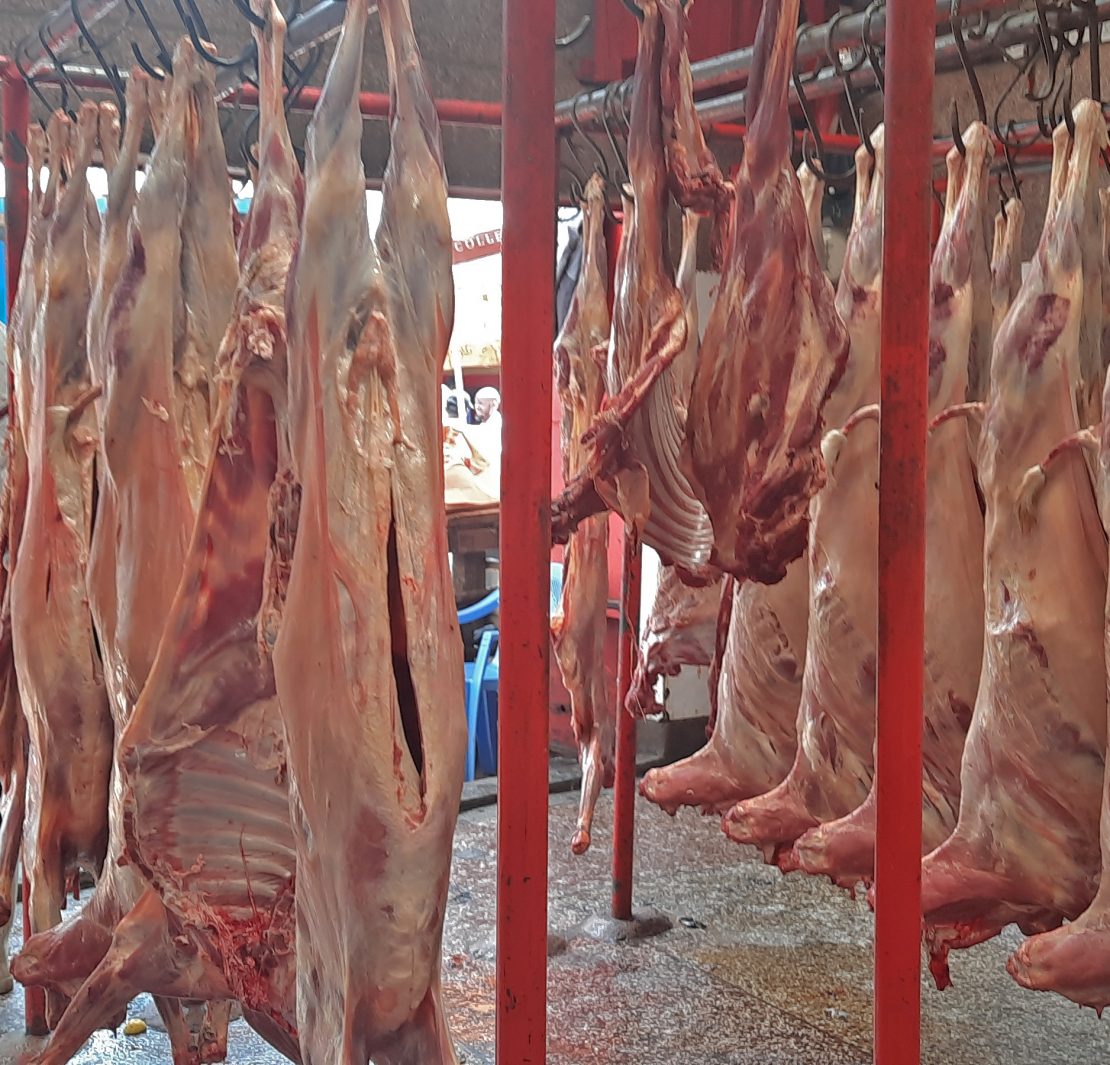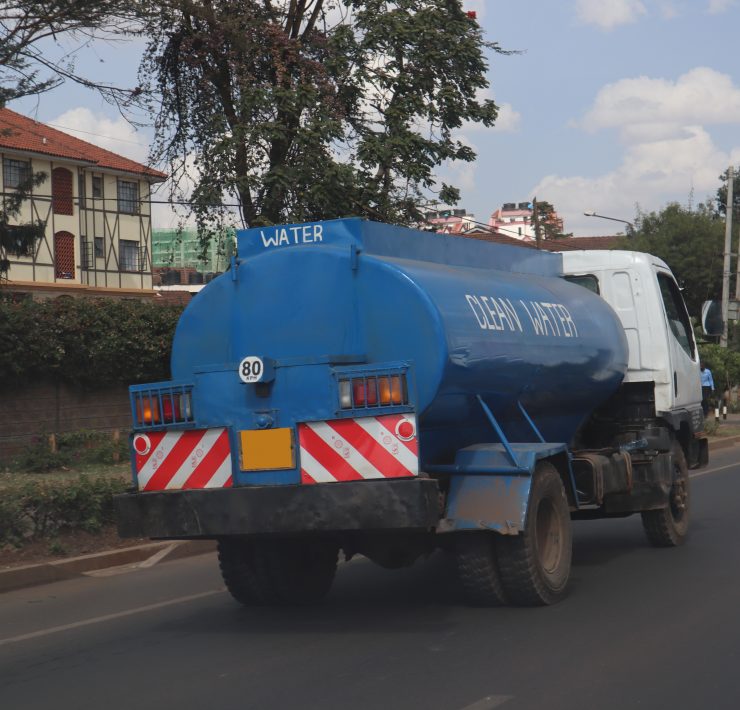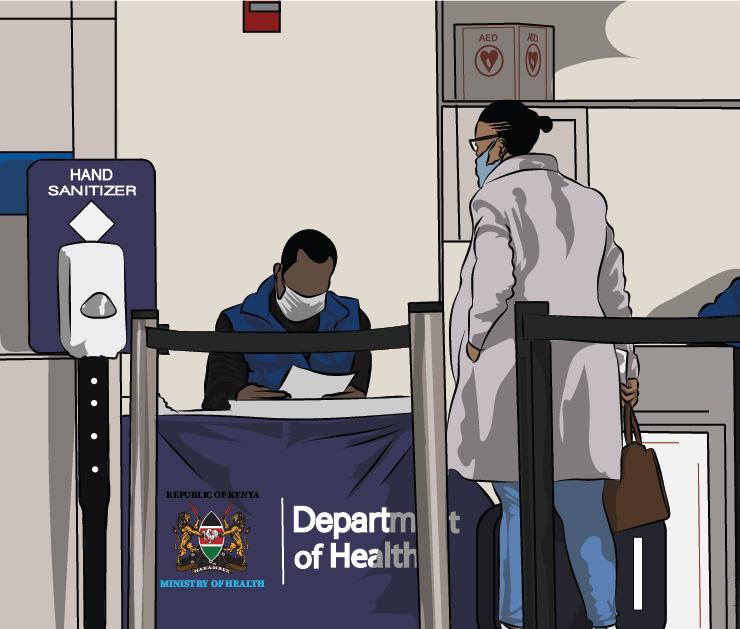On 30 January 2022, the airwaves were awash with news that Mamo Boru, the Director-General of the National Environment Management Authority (NEMA) had ordered the permanent closure of all fifteen slaughterhouses located in Kiamaiko, an area situated on one of the flanks of Mathare. Listed as County Assembly Ward No. 1450, Kiamaiko is one of the six wards in Mathare Constituency, with an estimated population of 33,824 people covering an area of approximately 0.7 square kilometres.
According to Nema, the charge was that the slaughterhouses had been releasing effluent into the Nairobi river. Nema’s firm ask, therefore, was that by 1 March 2022, the abattoirs were to relocate to the newly built Ksh 300 million slaughterhouse facility, commissioned by President Uhuru Kenyatta in Lucky Summer.
However, as the clock ticked, the Kiamaiko slaughterhouses stayed put, citing a misunderstanding.
Three weeks after Nema’s decree, I am standing a few metres outside the A.B. Slaughterhouse humming under my breath to keep the cold at bay. It is 6 a.m. on a chilly Saturday morning and I am two hours late to my Kiamaiko appointment. The man I am meeting, Bayana Abdi, is a tremendously amiable community leader and slaughterhouse owner, a business passed down to him by his father. I had contacted Bayana the previous evening, and it had pleased him that anyone would want to tell the story of Kiamaiko through the eyes of its traders. There was a collective fear that the economic fortunes of Kiamaiko, which has for more than five decades now depended on the goat meat trade, were dangling precariously. And so he offered me access to the workings of the business for a day, for a first-hand appreciation of the stakes.
The Makings of Nyama Ya Mbuzi
Given how early operations usually begin in Kiamaiko, I stand outside the slaughterhouse, hoping I haven’t missed out on much of the action. Indeed, I am not entirely out of luck. Bayana emerges, attired in a sky-blue kanzu. He is a rather plump, soft-spoken middle-aged man. We head straight to the goat market, which is easily the first stop for anyone looking to understand the intricacies of the enterprise. It is an enormous open space surrounded by loafing pens, lorries, and makeshift coffee joints where a group of men sit, playing ajua. I am told the men have either brought goats in those trucks or have come to buy some. I also notice young men in the open rear slats – three to a truck – fervently sweeping away gathered dust.
“I quit crime when I started a family,” Martin, one of the sweepers, tells me. “Now I sweep about six trucks a day, to provide for my kin with a genuine hustle.” Martin is concerned about the diminishing number of trucks ferrying goats into the market every morning, this following the government directive which has led to the withdrawal of many investors. He is afraid he might lose his livelihood and be forced to relapse into crime should the people at the top not come to an agreement sooner.
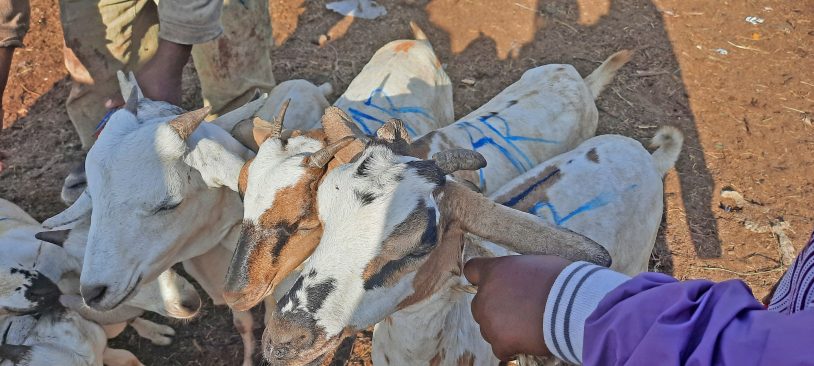
Goats branded with their buyer’s markings ready to be slaughtered. Photo by Kanyi Wyban/Debunk Media.
The market is a cacophony of noises and smells. Two men herding not less than fifty goats cross our path. One of them pulls a goat by its ear. The goat, bleating loudly, resists and is dragged along helplessly. The other goats follow quietly in line. I am curious as to why they bear different writings on their hides. Upon purchase, Bayana informs me, a goat is branded with its buyer’s markings, then taken to the pen for a few days, and later to the slaughterhouse, if not immediately.
The Recurring NEMA Dance
In the midst of our goat-buying, Bayana recalls how Nema struck in 2015, ordering the closure of the slaughterhouses following allegations of river pollution. The order was lifted for six months, which then resulted in a further extension until 2018 when the slaughterhouses were closed for a second time. It was a closed-door meeting between slaughterhouse owners and government agencies that saw the regulations rescinded again, this time with an official list of resolutions to be adhered to by the traders.
“They included establishing goat holding pens away from the slaughterhouses and taking all hides and skin to licensed tanneries daily,’’ Bayana says. ‘‘Further, all workers were to be medically examined and properly attired, with owners providing clean washing rooms for their staff. Owners were also expected to ensure daily collection of solid waste and abattoirs to install properly fitted and functioning sieves.’’
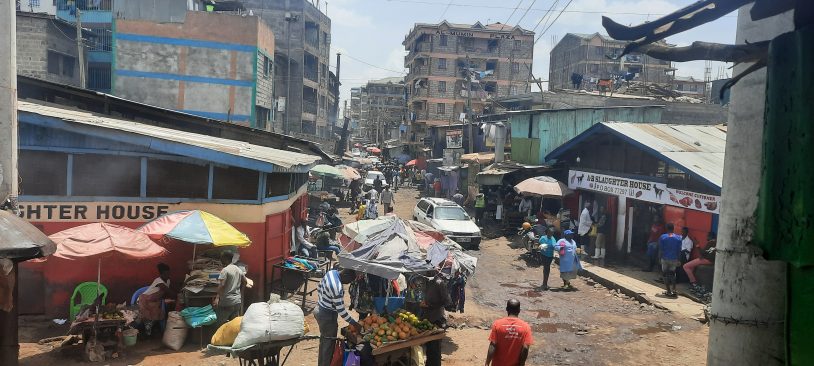
A.B Slaughterhouse (on the right) and other slaughterhouses in Kiamaiko, Nairobi. Photo by Kanyi Wyban/Debunk Media
But according to Bayana, despite the majority of traders abiding by these regulations, Nema is still not satisfied, claiming that Kiamaiko is a densely populated area with a poor road network, a state of affairs which makes the area unfit to absorb potential public health challenges presented by the slaughterhouses.
“What the media showed on TV is no longer the case here,’’ Bayana says of the free-running effluent which previously flowed into the river unmitigated. ‘‘We have cleaned up a lot of pollution, but it does not mean that we have dealt with the problem for good. The environment is something you work on constantly.”
Bayana maintains that Nema has become too hasty and radical in its approach. He tells me that the deadline issued demonstrates a government whose priorities are reversed. Unsettling a whole community’s economy, he explains, will come at a great cost – it is Nema’s job to provide more options, not less. He further insists that NEMA could, in fact, roll back regulations on the slaughterhouses while taking care of the environment. By his logic, true environmental conservation is about stewardship, not prohibition. Bayana speaks in a precise staccato that is softened by the light accent of his native Borana.
Halls of Long Knives
Soon, we are back to what is Bayana’s only inheritance from his father – the A.B Slaughterhouse.
There are two doors. The first, which is the main door, is the one through which customers come in. A massive weighing scale is suspended next to a set of knives. A man in a white apron seats there, cutting and weighing the meat to each customer’s needs. From this entrance, meat that is ready for sale can be seen hanging through a window. To the right is a counter, where all the transactions are recorded by Bayana’s niece, Hawa Hussein. Hawa tells me that from 4 a.m. in the morning, and throughout the day, more than sixty goats are brought under the knife in the slaughterhouse. This happens daily.
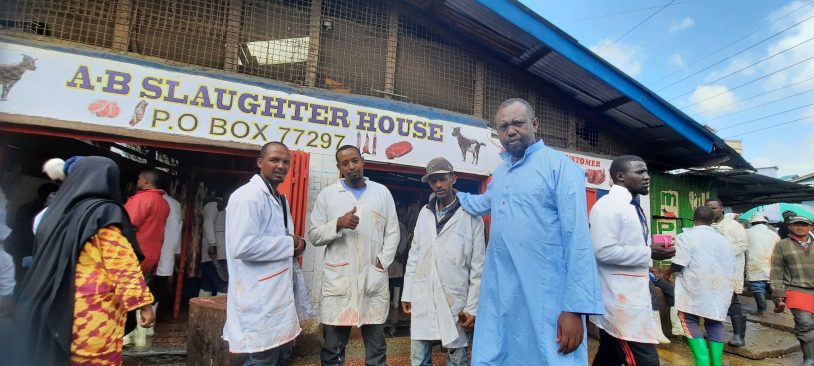
Bayana(wearing a light blue kanzu) and his colleagues standing outside the A.B Slaughter house in Kiamaiko, Nairobi. Photo by Kanyi Wyban/Debunk Media.
Across from us, a man holds a goat while his colleague slits its neck. The knife used is so sharp that it gets the job done in a single go. There are huge drums on standby, in which to drain all the blood from the lifeless animal. I ask one of the men-with-knives – who identifies himself as Yusuf – what he thinks of Nema’s claim on their hygiene standards. “Cheap fresh meat is what sets Kiamaiko apart,’’ Yusuf says. ‘‘There has never been complaints about complications caused by Kiamaiko meat. In fact, before any of it is sold, a qualified health inspector examines the meat, and there are seven of those stationed to serve the fifteen abattoirs in Kiamaiko.’’ What about releasing effluent into the river? ‘‘It no longer happens.’’
Doing It the Halal Way
As a rule, no non-praying Muslim is allowed to carry out the task of slaughtering, since it is paramount that the meat is halal. Therefore, the first step in slaughtering the animals is seeking Allah’s consent by invoking his name: a slaughter can only be carried out under Allah’s name and His name only. It is in line with these beliefs, I’m told, that one’s knife must be extremely sharp, to make one cut and not make the animal suffer.
By noon, when all the work is done, the cleaning begins. Rakes are used to collect everything that has been discarded, while knives are used to scrape off blood and tissue that has remained stuck to the walls. These and the castoffs collected in the sieve (that filters what the abattoir releases into the sewer system) are then stocked in bins, awaiting Nairobi City County garbage trucks that collect them every day. The hall is then thoroughly scrubbed using hose pipes, soap, and brooms.
By afternoon, the slaughterhouse looks like a posh showroom.
Saving Nairobi River
As part of ensuring the Nairobi River Regeneration Initiative is on course, Nema says it has identified 102 effluent discharge points attached to 43 facilities along the river’s ecosystem, including petrol stations, industries, hotels, and many others, where it intends to enforce restoration orders. Further, Nema outlines that many factories in the country have been contravening its provisions by discharging untreated effluent into public sewer lines without Effluent Discharge Licences (EDL).
Bayana welcomes Nema’s intentions, but remains emphatic that evicting Kiamaiko traders should not be the mission, considering environmental protection, human health and people’s livelihoods can all be done in sync. On his part, Molu Wako, a member of the Kiamaiko Slaughterhouse Owners Association (KSOA), believes that the fight against Kiamaiko is largely political. He is reluctant to give a comment on record, following threats on his life after he had made similar remarks on national TV. Wako observes that after the 2018 closure, the Nairobi City Water and Sewerage Company (NCWSC) had constructed a sewer near the gate of Valley Bridge Primary School, in a bid to improve the sanitation status of Kiamaiko. Since then, he says, their wastewater flows into the sewer, for which they pay an annual fee.
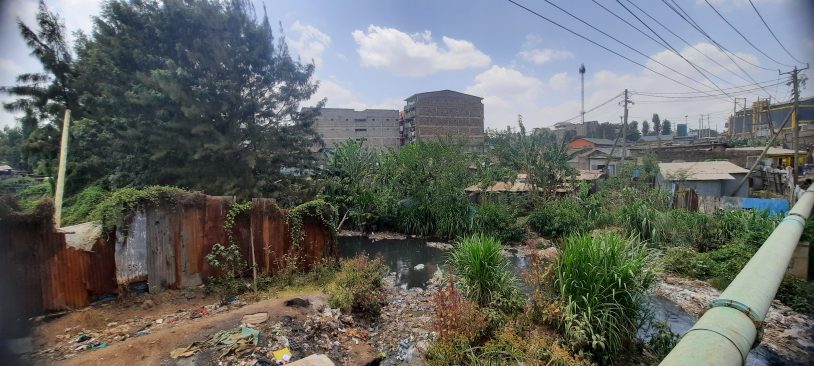
A section of the Nairobi River. Photo by Kanyi Wyban/Debunk Media
“As a matter of fact, our immediate river here is the Mathare River, which only joins the larger Nairobi River in Dandora Phase IV, about six kilometres away,” Wako says. “We, therefore, do not understand why Kiamaiko slaughterhouses are being targeted when there are numerous points of contamination, making the river black. Had the slaughterhouse been solely responsible, the river would instead be red.”
Everyone laughs. Bayana agrees.
Lives and Livelihoods
For Bayana and his family, the potential prospects of permanent closure remain profound. To him and others like him, their view is that the government needs to factor in the enduring loss the closure would inflict on livelihoods, given by the time one goat’s meat in Kiamaiko reaches plates in homes, tens of individuals have earned a living from it. And in that process, as you may now agree, it has fed more stomachs.
“Since river restoration projects depend greatly on public support and a change in human attitude, public engagement is very important and central to their successful implementation,” Bayana tells me as we leave the A.B slaughterhouse to savour Kiamaiko staples. He then concludes, seemingly helpless, even flustered, “Such is not the case in this matter. There has been no engagement between the government and Kiamaiko residents whatsoever. We were lucky the past two times. But who knows about the future? We are completely uncertain as to whether they will shut the place down.”
In the foreseeable future, it seems likely that traders will continue to be out before the crack of dawn, pulling goats to the slaughter. Someone will pack the meat and load the parcels onto motorbikes, someone will be rushing past, on their way to somewhere else. Cars, trucks, motorbikes, butcheries, coffee shops, kiosks, hotels, shops, fruit vendors, grocery stalls, miraa stands, and so on – all these people will keep waking up each morning to crowd the streets of Kiamaiko, unaware of what the future portends.
POSTSCRIPT
It has been three months since the lapse of Nema’s 1 March 2022 deadline. Fortunately for Bayana and his ilk, the abattoirs remain operational. Bayana believes the enforcement rule is being reconsidered, with ongoing talks between Nema and the representatives of the KSOA. Bayana now suggests that government agencies are supposed to ensure that the work informing new regulations is transparent, reasoned, inclusive, and not overly politicised. He also notes that “an extension would be a big relief to the community,” adding that a review of the Water Quality Regulations of 2006 is vital in ensuring “history doesn’t repeat itself.”

